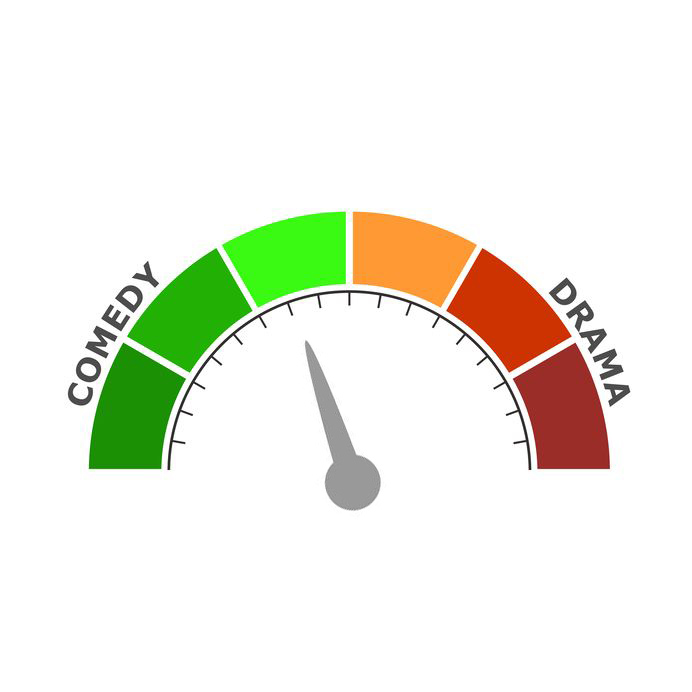Definition: dramatic irony in film is the existence of information presented to us as the audience that we learn before the characters in a story do.
To understand how to use dramatic irony in our storytelling, we must first establish the difference between creating suspense and creating surprise.
Key Takeaways
- Dramatic irony enhances suspense by letting audiences know more than the characters.
- It utilizes suspense and surprise to create dramatic tension and keep viewers engaged.
- Varied narrative perspectives, like first-person and third-person omniscient, enrich dramatic irony.
- Irony in screenwriting adds depth, foreshadows events, and engages audiences emotionally and intellectually.
Table of Contents
The difference between suspense and surprise
Surprise is the feeling we get when something happens to the characters we weren’t expecting.
Surprise is an immediate feeling. It happens suddenly and is over quickly. Once a surprise occurs, the dramatic tension of the moment dissipates just as suddenly as the surprise.
Suspense is the feeling of anxiousness we get when we know something the characters don’t and are on the edge of our seats worried for them – usually through using dramatic irony.
Suspense is the fuel that builds dramatic tension over time. The more we worry about and dread a particular outcome for our characters, the more invested we become in the dramatic tension.
How Suspense and Surprise Create Dramatic Tension
The best way to think about the differences between surprise and suspense and how to use them in a story is to think about how they create dramatic tension.
Dramatic tension is the driving force of a movie. It’s all about what comes next. The truth is that the best screenplays and films are always focused on what comes next.
The presence of suspense drives the story, while the threat of surprise drives the suspense.
When storytellers can keep the audience focused on what comes next, they create an environment where it becomes nearly impossible for the audience to look away.
While horror movies are often driven by surprises known as jump scares, thriller movies are driven by suspense that never seems to dissipate.
But the truth is, a mix of suspense and surprises drives the best horror movies. You can’t have a good horror without both!
The presence of suspense drives the story, while the threat of surprise drives the suspense.
The Difference between Surprise and Suspense, as explained by Alfred Hitchcock

Alfred Hitchcock explains it perfectly in this quote about a bomb under the table:
“Let’s suppose that there is a bomb underneath this table between us. Nothing happens, and then all of a sudden, “Boom!” There is an explosion. The public is surprised, but prior to this surprise, it has seen an absolutely ordinary scene, of no special consequence.
– Alfred Hitchcock
Now, let us take a suspense situation. The bomb is underneath the table and the public knows it, probably because they have seen the anarchist place it there. The public is aware the bomb is going to explode at one o’clock and there is a clock in the decor. The public can see that it is a quarter to one.
In these conditions, the same innocuous conversation becomes fascinating because the public is participating in the scene. The audience is longing to warn the characters on the screen: “You shouldn’t be talking about such trivial matters. There is a bomb beneath you and it is about to explode!”
In the first case we have given the public fifteen seconds of surprise at the moment of the explosion.
In the second we have provided them with fifteen minutes of suspense.
The conclusion is that whenever possible the public must be informed. Except when the surprise is a twist, that is, when the unexpected ending is, in itself, the highlight of the story.”
Dramatic Irony in Film From Different Point-of-Views
Now, how do you create suspense with dramatic irony?
You must first reveal information to the audience before you reveal it to the characters.
To do this, you must consider whose point of view you are using to tell this story.
Are we experiencing the story through one character’s point of view, a.k .a. first-person perspective?
Are there multiple point-of-view characters interacting together?
Or are you telling the story from a third-person omniscient point of view, where you bounce from scene to scene and character to character?
First-person perspective
If you are trying to create dramatic irony while telling the story from the first-person point of view, you will have to use subtle clues hidden in the scenes that the audience sees, but the lead character doesn’t.
Think about a missed call on an answering machine our character doesn’t hear.
In Hitchcock’s example, we pan under the table our character is sitting at to reveal the villainous character, taping a bomb to the table leg that our hero character doesn’t see.
Multiple points of view
In a story told from multiple points of view characters, you can create dramatic irony by having one character learn important information before another character does.
Think about a scene where Character A discovers that Character C is about to spring a trap on Character B – but before Character A can warn Character B, the very next scene is Character C already knocking on Character B’s door!
Third-person omniscient
To create dramatic irony in a story told from a third-person omniscient point of view, you have the most flexibility to reveal information as needed.
As such, you can write the story and cut away from any scene at any point to reveal new information for dramatic irony.
Keep in mind that writing any story this way can sometimes dissipate tension and keep the audience in a more cerebral mindset as they put the puzzle pieces together.
This is good for sprawling historical biopics or ‘whodunit’ crime mysteries.
Touch of Evil (1958). Dramatic irony in action example.
We open on a bomb in the hands of a faceless villain. Behind him, we watch a COUPLE turn a corner in an alleyway.
The man with the bomb rushes to a car and places the bomb in the backseat of the trunk, slinking away into the shadows.
The couple from before exits the alley and strolls straight up to the car in question. They get in and begin to drive away. We follow them as they drive off.
The more emotionally invested we are in a character, the more impactful the dramatic tension will be.
We have no idea who they are or what their dreams are. What happens from here is suspenseful, but it isn’t precisely heartbreaking.
Imagine if we had been following these characters the whole film until now. We would be on the edge of our seats, yelling at the screen!
In other words, the more emotionally invested we are in a character, the more impactful the dramatic tension will be.
Dramatic Irony in Tragedy and Comedy

Dramatic irony isn’t just the stuff of thrillers and horror movies.
Dramatic irony is the fuel that burns in the story engine of good drama – hence the name “dramatic” irony.
Nothing is more dramatic than one character with a secret that another character doesn’t know about, but we, as the audience, do.
Drama makes great comedy, and dramatic irony is an excellent tool for both tragedies and comedies.
It’s the stuff of Greek and Shakespearean tragedy.
Think about the dramatic irony at the tragic end of Romeo and Juliet or the epic classic Oedipus Rex.
Shakespeare’s comedies are also some of the best examples of executing dramatic irony.
Think of all the mistaken identities, mix-ups, and dramatic irony inherent in classics like Taming of the Shrew, 12th Night, or A Midsummer’s Night Dream.
Dramatic irony is the fuel that burns in the story engine of good drama – hence the name “dramatic” irony.
Dramatic irony is also inherent in the classical story structure of the romantic comedy genre, as each romcom is built around a “tragic misunderstanding.”
The tragic misunderstanding is a miscommunication between the two leads, who are otherwise perfect for each other.
These tragic misunderstandings are almost always set up using dramatic irony.
As the audience, we know it’s a misunderstanding, but our leads don’t. The story’s conclusion only comes when they finally realize what we’ve known all along: that it was all just one big misunderstanding.
Up Next: how to use Situational Irony in Film
So that concludes this article on dramatic irony in film.
Next up, we shall take a closer look at situational irony in film.

